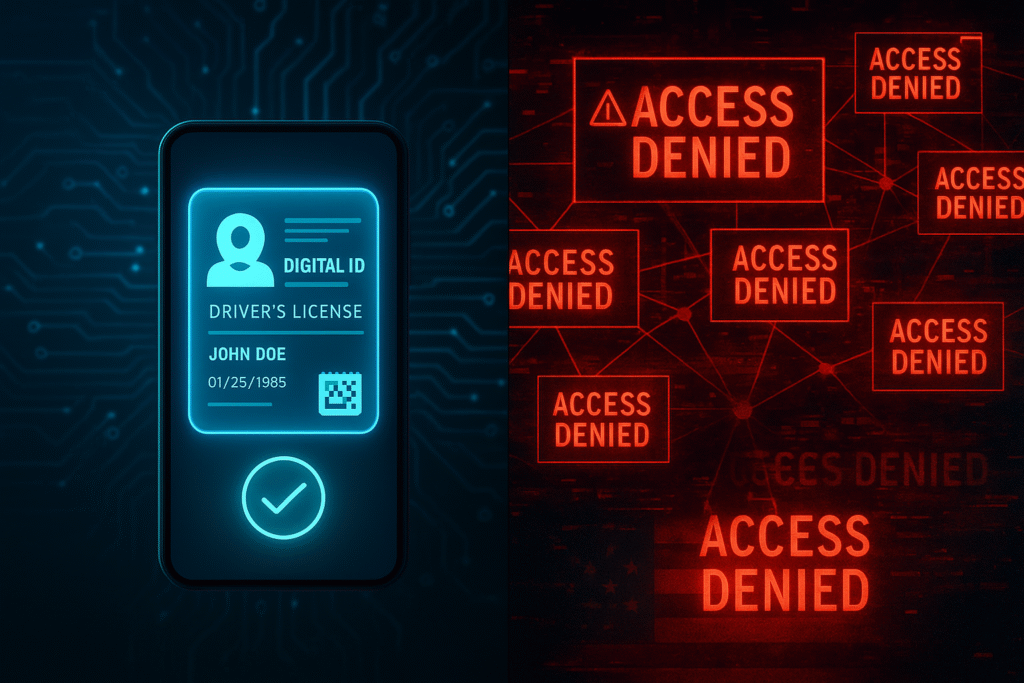
In June 2025, the Trump administration issued a sweeping executive order repealing President Biden’s digital identity directive. The move stunned cybersecurity professionals, tech executives, and federal agencies alike. The timing could hardly have been worse. Just months earlier, the United States was rocked by a wave of North Korean deepfake job scams, and the federal government was still reeling from the estimated $135 billion in pandemic-related identity fraud.
While digital identity may sound like a wonky topic, the implications of the Trump digital ID repeal are both immediate and dangerous. Biden’s original executive order, issued in January 2025, was one of the most ambitious attempts to modernize America’s outdated digital infrastructure. It aimed to strengthen mobile ID security, eliminate fragmented authentication systems, and mitigate digital verification risks, especially those posed by foreign adversaries like China and North Korea. That effort is now halted.
The Trump order didn’t just cancel Biden’s plan. It replaced it with nothing. No new framework. No alternative policy. No roadmap. According to Politico, even former officials who typically support deregulation expressed concern that the repeal of the Biden digital identity executive order left the nation’s cyber defenses more vulnerable, not less.
This article breaks down what Biden’s plan actually proposed, what Trump’s order eliminated, and why this policy vacuum could be exploited by hostile nations and cybercriminals. We’ll also examine how our global competitors are racing ahead in secure digital identity systems and what’s at stake if the U.S. continues to lag behind.
To get weekly breakdowns like this on AI, cybersecurity, and digital policy, sign up for our newsletter here.
To understand what was lost, we first need to look at what the Biden digital identity executive order set out to accomplish.
What Was in Biden’s Digital ID Order?
National Push for Mobile IDs and Login.gov Integration
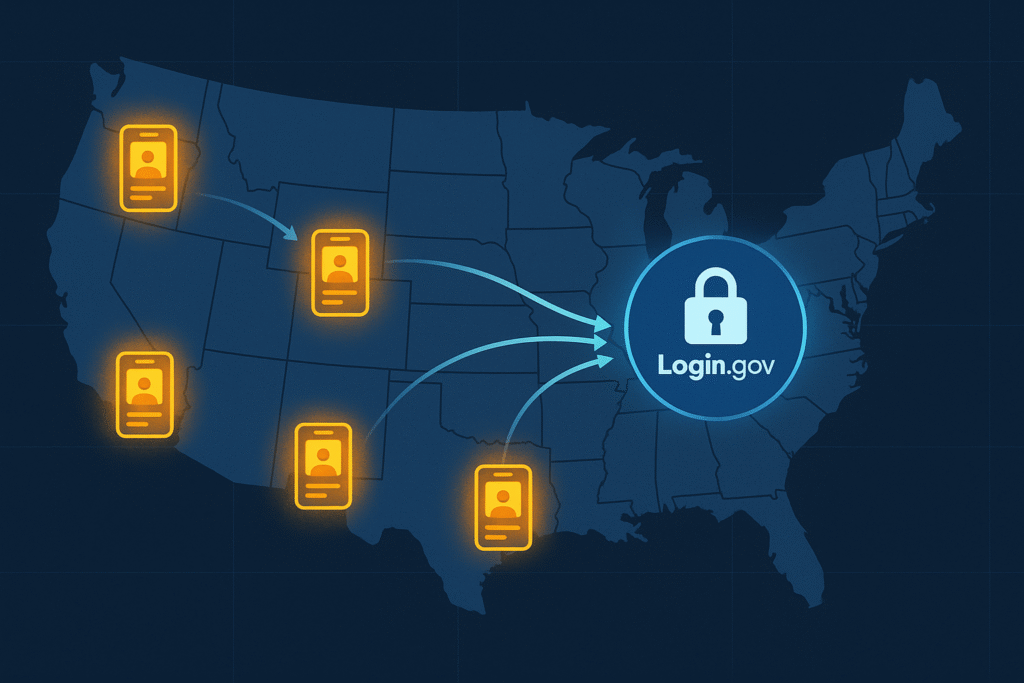
The Biden digital identity executive order, signed in January 2025, laid out a multi-agency plan to modernize identity verification across federal systems. A cornerstone of the initiative was the rollout of mobile driver’s licenses (mDLs), a digital version of state-issued IDs that would be cryptographically secured and accessible via smartphones. These weren’t gimmicks. They were designed to provide verifiable, privacy-enhancing credentials that could be used in both public and private sectors.
To encourage adoption, Biden’s order allocated grants to help states build mDL infrastructure. States were not required to implement the program but were offered federal support if they did.
In tandem with mDLs, the EO promoted the expansion of Login.gov, a secure sign-on platform used by agencies such as the IRS and Social Security Administration. Login.gov allows users to authenticate their identity across multiple federal services using a single account, reducing the need to manage different passwords or repeat verification steps. Integrating these systems under a shared standard was a key step toward streamlining citizen access and enhancing cybersecurity.
Focus on Privacy and Non-Surveillance
A central feature of the Biden plan was its privacy-preserving design. Critics of past digital ID proposals, particularly those in other countries, have raised alarms about government overreach and surveillance. Biden’s EO attempted to address those concerns head-on.
Rather than collecting new biometric data or mandating universal enrollment, the order emphasized user control and voluntary adoption. Agencies were directed to ensure that any digital ID system they implemented adhered to privacy best practices, specifically avoiding location tracking, real-time monitoring, or centralized behavioral databases.
A Unified Federal Standard
The broader goal was to tackle what many experts call the fragmentation crisis in digital identity. Currently, dozens of federal agencies use different systems for identity proofing, access control, and authentication, creating security blind spots that hackers exploit.
By developing a unified framework and encouraging interagency cooperation, the Biden digital identity executive order sought to reduce digital verification risks, improve citizen trust, and enable scalable cybersecurity solutions across the government. This standardization would not only reduce identity fraud but also eliminate costly redundancies and weak points that adversaries routinely exploit.
That vision was short-lived. The Trump digital ID repeal dismantled key elements of Biden’s plan and left agencies without direction.
What Trump’s Executive Order Repealed
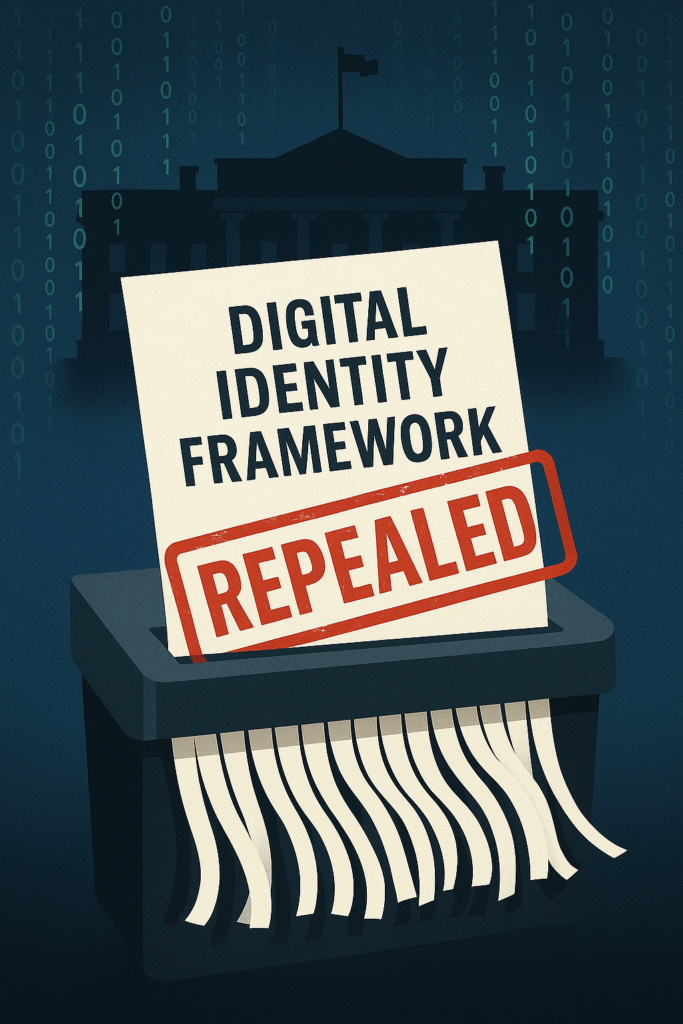
Elimination of Mandatory Digital ID Adoption
In June 2025, President Trump signed an executive order that revoked the mandates and funding mechanisms established by Biden’s digital identity plan. This was not a partial rollback. It was a full-scale repeal. Under the new directive, federal agencies are no longer required to accept mobile driver’s licenses (mDLs), and the financial support earmarked for state-level implementation was rescinded.
Without this funding, states that had already begun pilot programs, some of which were in advanced stages, are left scrambling to maintain momentum or secure alternative support. Login.gov expansion efforts have also been paused, with agencies now instructed to evaluate their identity systems independently rather than through a centralized federal framework.
This shift effectively removes any cohesive strategy for improving mobile ID security or streamlining citizen access across federal systems, and it weakens the interoperability that Biden’s order was explicitly designed to enhance.
Rollback of Secure Software Attestation Requirements
Trump’s executive order didn’t stop at identity verification. It also revoked cybersecurity protocols that required federal contractors to submit software attestations to the Cybersecurity and Infrastructure Security Agency (CISA). These attestations, which had become standard under Biden’s broader cyber strategy, helped agencies verify that the software they were using was built according to secure development practices and free from known vulnerabilities.
Under the new policy, these attestations are now voluntary, and contractors may self-certify their cybersecurity compliance without any formal accountability.
Cybersecurity experts argue that this rollback introduces serious digital verification risks. Without enforced attestations, it becomes easier for compromised or poorly vetted software to make its way into federal systems, a concern heightened by the growing sophistication of supply chain attacks from foreign adversaries.
Political Framing and Controversial Justifications
The rationale offered by the Trump administration has sparked intense controversy. According to public statements and excerpts from the order, the repeal was driven by concerns that digital IDs could be used to “enable entitlement fraud” or “grant access to undocumented immigrants.” These claims were presented without evidence, and critics argue that they reflect political messaging rather than cybersecurity logic.
Notably, Biden’s digital ID plan did not include provisions for undocumented immigrants or mandatory enrollment. Participation was voluntary, and identity verification systems were limited to legal residents interacting with federal agencies. Nevertheless, the political framing was effective in rallying opposition to the initiative.
Experts like Jeremy Grant, who led digital identity initiatives under the Obama administration, criticized the Trump digital ID repeal for dismantling what he described as “common-sense, modest measures” intended to improve the security of public-sector identity systems. Grant emphasized that these provisions were broadly supported within the cybersecurity community and viewed as essential steps toward modernizing federal digital infrastructure.
The result is a sharp policy reversal with broad implications. With no alternative framework proposed, the Trump digital ID repeal leaves a vacuum in both federal guidance and national cybersecurity posture.
To grasp the full impact of that decision, it’s important to examine why digital identity infrastructure matters at every level of government and society.
Why Digital ID Infrastructure Matters
Critical National Security Component
Digital identity is no longer a niche IT issue. It is a pillar of national security. The Department of Homeland Security (DHS) and the National Institute of Standards and Technology (NIST) have both designated digital identity systems as part of the nation’s critical infrastructure, especially as identity compromise becomes a preferred entry point for attackers.
Without a secure way to verify who is accessing federal systems, adversaries can impersonate users, steal credentials, and move laterally across networks. Experts agree that the absence of strong, standardized identity proofing makes U.S. systems more vulnerable, not just to phishing, but to more advanced intrusions and insider threats.
One former White House cybersecurity advisor noted, “We don’t let people walk into government buildings without checking IDs. Why should our digital infrastructure be any different?” That analogy underscores a basic truth: identity verification is the front door of cybersecurity. Without it, there’s no real perimeter.
Massive Economic Cost of Identity Fraud
The repeal of the Biden digital identity executive order also ignores the staggering economic consequences of weak identity controls. According to government audits and press reports, over $135 billion in pandemic relief funds were lost to identity-based fraud schemes during COVID-19, much of it involving stolen or synthetic identities used to claim unemployment and business loans.
This is not a historic footnote. It’s an ongoing crisis. Federal and state agencies continue to report incidents where outdated ID verification systems are exploited for fraud. In some states, benefits were issued to the same identity multiple times because systems couldn’t detect duplication or verify applicants in real-time.
Meanwhile, in the private sector, companies are facing soaring costs tied to account takeovers and identity theft. A 2024 report by Javelin Strategy & Research found that U.S. businesses lost more than $16 billion annually to identity fraud, a number projected to rise as criminals adopt AI to spoof or fabricate identities.
Without improvements in digital verification, these losses are expected to continue or accelerate. Biden’s plan targeted precisely these vulnerabilities, making the Trump digital ID repeal not just a cybersecurity setback, but a costly one.
Identity as a First-Strike Vulnerability
In nearly every major cyberattack involving a government system, identity is the first domino to fall. Whether it’s phishing campaigns, credential stuffing, or the use of compromised administrator accounts, attackers rely on poor identity management to gain a foothold.
The SolarWinds breach, for example, involved compromised credentials that allowed attackers to escalate access across government networks. Similarly, the Colonial Pipeline attack leveraged password reuse and weak identity governance.
In 2023 and 2024, North Korea’s Lazarus Group and Chinese advanced persistent threat (APT) teams increasingly relied on forged digital identities to infiltrate sensitive sectors, posing as job applicants or vendors. These attacks often evaded detection because there was no standardized way to authenticate identities across federal systems.
The Biden plan attempted to close these gaps. It would have allowed agencies to verify that a user or contractor was who they claimed to be, whether through mobile ID, Login.gov, or secure third-party credentials. With the plan repealed, those identity seams remain open.
This is why national security experts have called digital identity a cybersecurity priority on par with encryption and network defense. Without a verified identity layer, even the strongest firewalls can be bypassed.
The loss of a coordinated strategy carries consequences. Without federal leadership, critical gaps are emerging across digital identity systems.
The Hidden Risks of Repeal
Growing Exposure to State-Sponsored Cybercrime
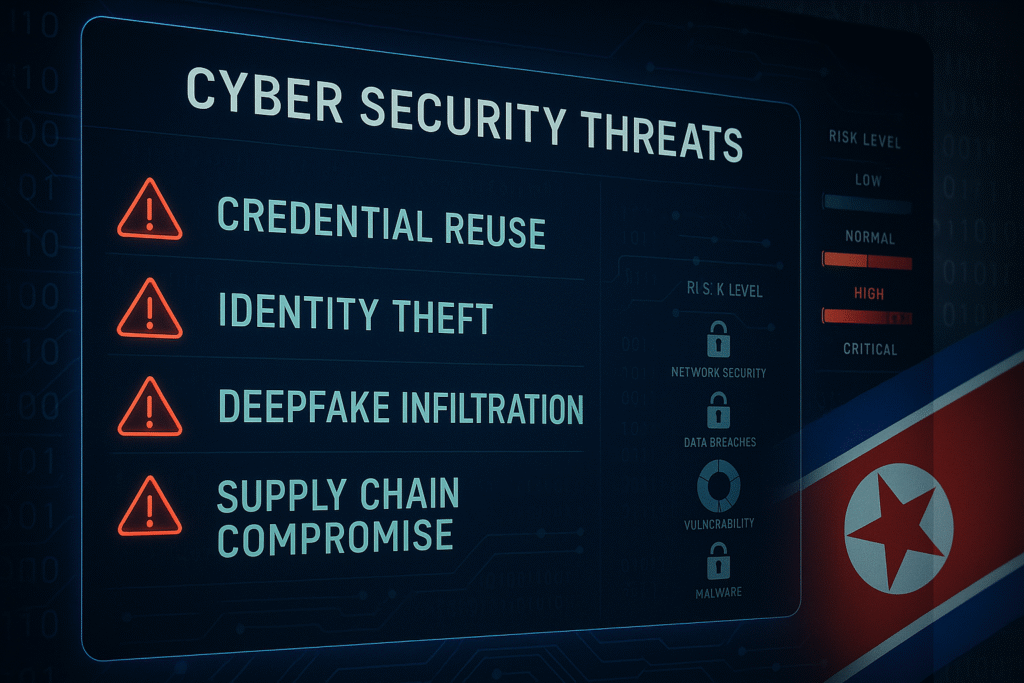
The Trump digital ID repeal did more than halt a modernization initiative. It removed what many experts considered the federal government’s best chance at preventing identity-based attacks from advanced persistent threats. This includes some of the most formidable and well-resourced cyber adversaries in the world. Among them is North Korea’s Lazarus Group, which has become notorious for leveraging stolen credentials and synthetic identities to infiltrate financial institutions, crypto platforms, and federal contractor networks.
Since 2020, Lazarus has been linked to multiple identity-based infiltration schemes, including deepfake job interviews and forged LinkedIn profiles targeting U.S. firms. These are not fringe threats. North Korea has stolen more than $2 billion through such methods, much of it used to fund missile programs and evade sanctions.
The Biden digital identity executive order aimed to block these exploits by advancing mobile ID security and requiring more rigorous authentication standards across federal systems. Without this framework, the identity seams remain open. That creates a fertile attack surface for hostile nations and criminal groups alike.
Removing those protections without offering a replacement invites exploitation. The U.S. remains one of the few major economies without a comprehensive digital ID infrastructure, and adversaries are increasingly aware of that vulnerability.
This is one reason the topic was featured in our recent blog, AI-Led Cyberattack: 7 Terrifying Signs You’ll Miss Until It’s Too Late, which explores how AI is already scaling these attack vectors in the absence of coordinated defenses.
Erosion of Trust in Public Infrastructure
Another consequence of the repeal is the erosion of trust in the very institutions tasked with protecting the public. Digital ID frameworks like Login.gov were never just about convenience. They were about consistency, transparency, and security. When agencies use disparate identity systems and verification methods, it becomes harder for citizens to understand or trust how their data is being used.
The Biden digital identity executive order aimed to unify these systems while offering clear standards for privacy and control. When that structure was removed, so was the federal government’s ability to ensure uniform protections. As a result, individuals are left to navigate a fragmented identity landscape, one that varies not only between federal and state levels but even between agencies.
From a policy standpoint, this fragmentation creates compliance confusion. From a technical standpoint, it introduces significant digital verification risks. Agencies cannot easily share data, validate access credentials, or detect anomalies when their systems are built on different standards. This is not just a burden for IT staff. It’s a systemic failure that can be exploited at scale.
For example, a contractor cleared by one agency might not be properly validated when accessing another, making lateral movement within government systems easier for bad actors. The removal of the Biden framework not only jeopardizes national security but also weakens the public’s confidence in government systems meant to safeguard them.
Loss of Policy Momentum and Federal Leadership
Perhaps the most far-reaching consequence of the Trump digital ID repeal is the chilling effect it has had on policy momentum. When the federal government reverses a major initiative without replacing it, it signals to states, vendors, and allied governments that this domain is in disarray.
States that had already begun mobile ID pilot programs with federal grant support were left in limbo. Vendors developing compliant authentication tools have paused their rollout. International partners who had expressed interest in interoperability with U.S. systems now see a country with no defined path forward.
The absence of leadership is not just symbolic. It creates real vulnerabilities. Digital ID systems are not static. They require constant updates, public-private collaboration, and federal coordination. Without that scaffolding, even well-meaning individual efforts fail to scale.
Jordan Burris, a former federal chief of staff for the Office of Management and Budget’s Federal CIO, put it clearly: the repeal gives nation-states and cybercriminals the upper hand by freezing progress and silencing leadership.
These risks are not playing out in isolation. Around the world, other governments are aggressively building secure identity frameworks while the U.S. lags behind.
Global Context: How U.S. Adversaries Are Advancing
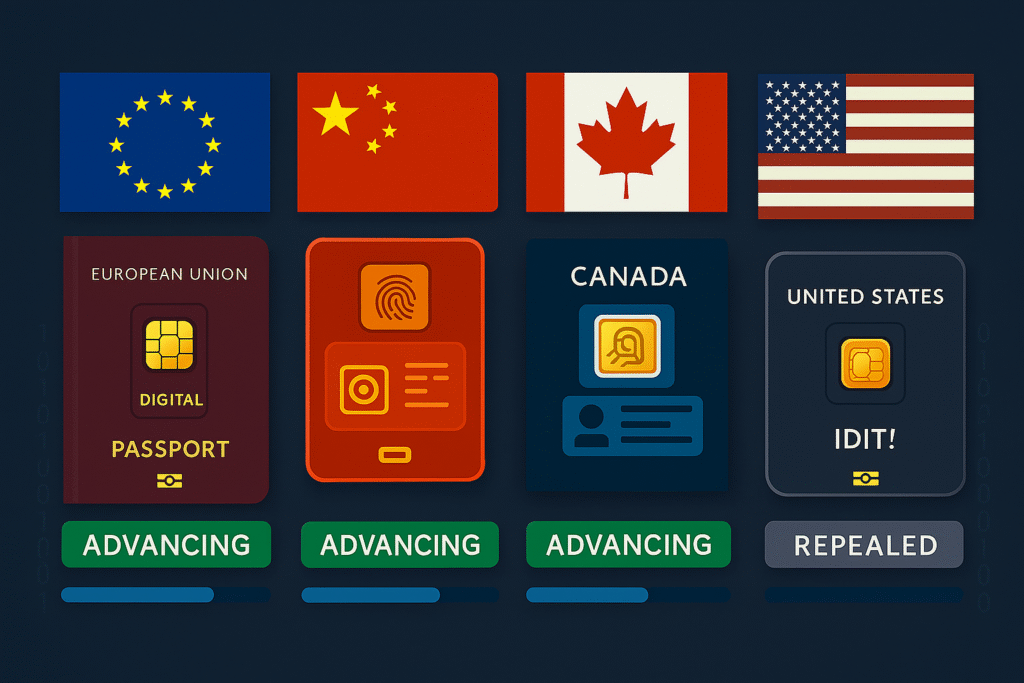
China’s National Digital ID Expansion
While the United States grapples with the consequences of the Trump digital ID repeal, other global powers are accelerating their efforts to modernize digital identity infrastructure. China, in particular, has made digital identity a cornerstone of its national strategy. The Chinese government has already implemented a national ID system that integrates biometric data, social credit scores, and public service access, creating a unified platform that supports internal surveillance and international expansion.
China is also exporting its digital ID model through its Belt and Road Initiative. Dozens of developing nations are now adopting Chinese-built platforms for digital identity, which are often tied to public services, financial infrastructure, and even telecom networks. These deployments serve a dual purpose. They embed Chinese technology standards globally and extend Beijing’s geopolitical influence.
Security experts warn that China’s expansive digital identity model, though authoritarian in design, allows for robust digital verification across sectors. In contrast, the United States now lacks a coordinated federal strategy after abandoning the Biden digital identity executive order. The result is a widening gap in both technological leadership and cybersecurity resilience.
The contrast is especially stark when it comes to mobile ID security. China has already implemented digital IDs accessible via smartphone for hundreds of millions of citizens. These systems, while controversial in terms of privacy, are far ahead of where the U.S. stands today. The removal of Biden’s initiative has left American agencies and states without the tools or funding to catch up.
North Korea’s Identity-Based Cyber Infiltrations
Few countries have exploited the United States’ identity weaknesses as effectively as North Korea. Its state-sponsored hacking groups, particularly the Lazarus Group, specialize in using false or stolen identities to penetrate Western networks. In the last several years, North Korea has deployed fake job applications, deepfake interviews, and spoofed business personas to gain access to sensitive U.S. infrastructure.
These are not isolated cases. The Federal Bureau of Investigation and multiple cybersecurity firms have confirmed that North Korea’s campaigns have resulted in more than $2 billion in theft from U.S. and allied entities. These breaches are part of a broader pattern of cyberattack threats from North Korea that continue to evolve and scale. In some cases, attackers impersonated legitimate job candidates at tech firms, using deepfakes to pass identity verification during virtual interviews.
Our recent blog, North Korean Deepfake Job Scam: 7 Shocking Red Flags, explores how these schemes work in detail. The Biden digital identity executive order would have closed many of the pathways these actors exploit, especially by standardizing and securing onboarding and identity proofing processes across agencies and contractors.
Without those protections, digital verification risks remain acute. Agencies and businesses lack a centralized mechanism for verifying applicants, making it easier for foreign actors to gain access and persist undetected. The Trump digital ID repeal dismantled a key line of defense at a time when North Korea’s attacks are becoming more aggressive and sophisticated.
Europe and Allies Are Moving Forward
While the United States debates and reverses progress, its allies are pressing ahead. The European Union has launched a comprehensive initiative under the eIDAS regulation to create a digital identity wallet for all citizens. This wallet allows individuals to authenticate themselves across borders, access government services, and sign legal documents electronically with full regulatory support.
Canada and Australia are also actively advancing national digital identity strategies. These programs emphasize user consent, mobile ID security, and strong privacy controls while creating uniform standards for both public and private use. Each of these countries has made digital identity a cybersecurity and economic priority.
In this global context, the Trump digital ID repeal does more than halt domestic progress. It removes the United States from a rapidly forming international consensus around secure and interoperable identity systems. The result is both a technological disadvantage and a weakened cybersecurity posture.
The lack of a unified approach also complicates international cooperation on cybercrime and data sharing. As allies develop their own verification frameworks, the United States risks becoming the weak link in multilateral cybersecurity efforts. With digital verification risks mounting and cyberattack threats from North Korea and China on the rise, the absence of leadership is more than symbolic. It is strategically damaging.
As adversaries move forward, the U.S. remains stalled. Without a replacement strategy, the country faces growing exposure to cybercrime and strategic setbacks.
What Comes Next Without a Replacement Strategy
No Clear Federal Roadmap or Successor Plan
Since the Trump digital ID repeal took effect, federal agencies have been left without a unified direction for digital identity modernization. The Biden digital identity executive order was not simply a policy recommendation. It was a detailed, cross-agency directive that provided funding, timelines, and technical standards for implementing secure digital ID systems, including mobile ID security protocols and interagency integration.
By revoking the order without offering a replacement, the federal government has effectively abandoned its leadership role in one of the most urgent areas of cybersecurity. Agencies are now expected to continue authentication and identity management using fragmented, legacy systems that vary in rigor, format, and security posture. This fragmentation exposes the entire federal ecosystem to increased digital verification risks. It also creates compliance confusion for contractors and private-sector partners that rely on federal standards to guide their cybersecurity architecture.
The Cybersecurity and Infrastructure Security Agency (CISA) and the National Institute of Standards and Technology (NIST) have both emphasized the need for centralized oversight and governance. Yet, as of mid-2025, no alternative framework or successor directive has been issued by the Trump administration. The vacuum created by the repeal is not only delaying progress. It is giving threat actors more time to exploit outdated systems while the federal government remains stalled.
Congressional Inaction and Gridlock
Efforts to codify digital identity modernization into law have repeatedly stalled in Congress. Despite bipartisan agreement on the need to improve identity security and reduce fraud, proposed legislation has either died in committee or failed to gain sufficient traction. This paralysis has become more problematic in the wake of the Trump digital ID repeal, which removed the executive branch’s most comprehensive tool for driving federal action.
Several lawmakers had hoped that the Biden digital identity executive order would serve as a springboard for broader legislation, giving Congress time to build a more permanent statutory framework. That opportunity has now been lost. Without executive guidance or legislative action, agencies and private-sector stakeholders are stuck in a holding pattern.
State-level pilots are continuing in some areas, but these efforts lack coordination and interoperability. The loss of federal funding for mobile ID security programs has further reduced the incentive for state governments to invest in long-term planning. Meanwhile, technology vendors that had been developing identity tools aligned with the Biden order are facing uncertainty about future requirements and market viability.
This gridlock leaves the U.S. uniquely exposed. Other countries are moving forward with national strategies, while the United States struggles to define even the basic contours of its digital identity architecture.
Opportunity for Adversaries to Exploit the Gap
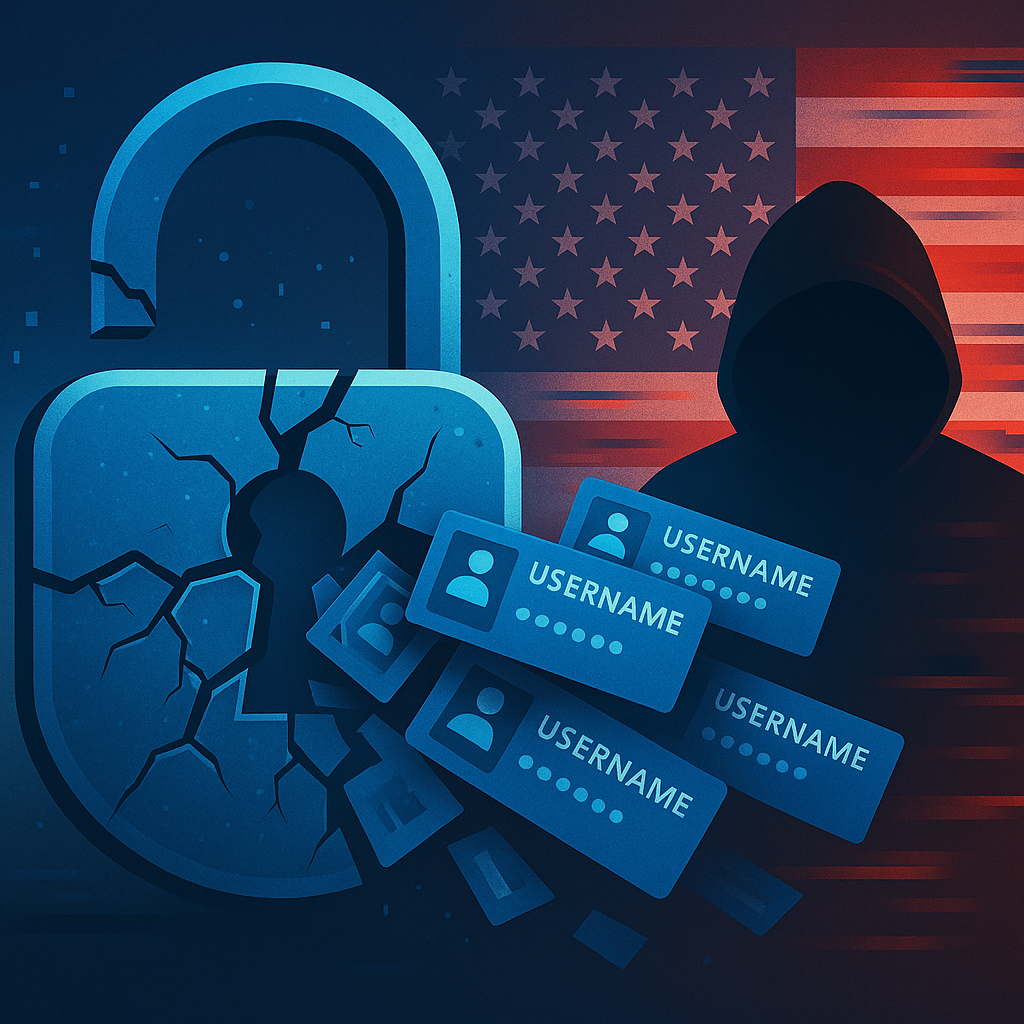
In cybersecurity, delays are opportunities. The longer a vulnerability remains unaddressed, the more time adversaries have to exploit it. The repeal of the Biden digital identity executive order created exactly that kind of delay. Without a federal framework for verifying digital identities, hostile actors have a clearer path to infiltrate sensitive systems, whether through phishing, synthetic identities, or compromised contractor access.
These risks are amplified by the growing use of artificial intelligence to automate identity forgery and mimic legitimate behavior. Foreign adversaries like North Korea and China are investing in advanced capabilities to impersonate employees, bypass onboarding checks, and remain persistent within U.S. systems. The failure to implement standardized digital ID protections makes these tactics even more effective.
For example, a North Korean actor can now apply for a remote tech job in the United States, pass a virtual interview using a deepfake, and gain access to sensitive backend systems, all without triggering alarms. Biden’s original plan sought to close these gaps through stronger identity proofing, centralized verification systems like Login.gov, and secure mobile ID frameworks. The Trump digital ID repeal dismantled that strategy entirely.
Our investigation into Telegram Zero-Day Vulnerability: 5 Terrifying Risks You Must Know, illustrates how high-value platforms become prime targets when verification and access controls are weak. Without a coordinated national strategy, U.S. systems are becoming increasingly attractive to adversaries seeking to exploit both technical vulnerabilities and bureaucratic indecision.
The longer this policy void persists, the more likely it is that the next large-scale breach will be traced back to the very identity seams that the Biden digital identity executive order was designed to address.
All of this points to a clear conclusion: the United States cannot afford to treat digital identity as an afterthought.
Conclusion and Future Outlook
The Growing Imperative of Digital ID Modernization
The consequences of the Trump digital ID repeal extend far beyond politics or policy disagreements. They touch on the core of U.S. national security, economic stability, and personal privacy. As the world becomes increasingly digital, identity verification is no longer a technical luxury; it is a foundational pillar of the internet’s infrastructure.
The Biden digital identity executive order sought to create a secure, standardized, and privacy-preserving framework for identity verification. It aimed to modernize the U.S. government’s approach to cybersecurity, address the rising tide of digital verification risks, and equip the federal government with the tools necessary to thwart increasingly sophisticated cyberattack threats from North Korea and other adversaries. By tearing up this plan, the Trump administration has left the U.S. vulnerable to a range of threats, from data breaches to full-scale cyberattacks.
An Accelerating Global Race for Digital Identity Solutions
The need for a comprehensive digital identity strategy is global. Countries around the world are investing heavily in secure, mobile-first identity verification systems. While the U.S. falters, global competitors like the European Union, Canada, and even China are advancing their own national standards for mobile ID security and digital identity frameworks. Some nations have even moved forward with plans to integrate biometrics and artificial intelligence into their identity systems, further complicating the landscape for the U.S. to catch up.
The delay in U.S. policy presents not just a national security risk but an economic one as well. Private-sector companies that work with the federal government—particularly those in the finance, healthcare, and defense sectors—are left grappling with disparate authentication systems. This fragmentation drives up costs, creates inefficiencies, and makes it more difficult for businesses to meet cybersecurity standards. Meanwhile, adversaries can exploit the lack of a cohesive framework to infiltrate U.S. systems.
The Path Forward: A Unified Approach to Digital Identity
The U.S. needs to urgently reconsider its approach to digital identity. The Trump digital ID repeal has left a gaping policy hole that will only widen as technology evolves and threats become more sophisticated. To address this, the federal government must prioritize the following:
- Reinstate Digital Identity Frameworks: Congress should work alongside the Biden administration to pass a permanent, legislated digital identity framework that unifies federal agencies and provides incentives for state-level implementation. This framework must prioritize mobile ID security, safeguard privacy, and address digital verification risks.
- Enhance Public-Private Cooperation: The private sector must be brought into the fold. Collaborations between the federal government, technology providers, and cybersecurity experts are essential to developing secure, scalable identity verification solutions. This can be accomplished through industry-led standards and cooperative initiatives between government agencies and their private-sector partners.
- Focus on Cybersecurity and Privacy: Moving forward, any new digital identity policy must take lessons from the Biden administration’s plan, focusing on user privacy and security. This is especially important given the rising concerns about digital surveillance and unauthorized data collection. Identity systems must be decentralized and user-controlled, with privacy protections firmly embedded at the core.
- Rebuild the Trust of the American Public: Trust in digital identity systems is paramount. The government must ensure that any identity framework protects citizens from fraud, identity theft, and unauthorized access, while balancing security with personal privacy. Transparency and effective communication are critical to rebuilding public confidence in these systems.
The Bottom Line
The repeal of the Biden digital identity executive order represents a critical inflection point in U.S. cybersecurity policy. Without a clear replacement, the country faces an uncertain future where the risks of digital identity fraud, cyberattacks, and supply chain breaches grow exponentially. The U.S. can no longer afford to delay on this issue. Digital identity modernization is not just a technological necessity—it is a national security imperative.
As the global landscape for digital identity evolves, the U.S. must find a way to re-establish itself as a leader in secure, privacy-preserving digital infrastructure. Failure to do so will not only leave the country vulnerable to cyberattack threats from North Korea and other adversaries, but also undermine confidence in the very systems designed to protect the American people. The time to act is now.
To get breakdowns like this each week, including how cyber policy shifts could affect your organization or agency, sign up for the Quantum Cyber AI newsletter.
Key Takeaways
- The Trump digital ID repeal removed critical protections without providing a replacement, creating a policy vacuum that increases national vulnerability.
- The Biden digital identity executive order aimed to modernize and unify fragmented federal ID systems, strengthen mobile ID security, and reduce digital verification risks.
- The repeal leaves federal agencies without guidance and weakens public and private sector defenses against credential-based attacks.
- Cyberattack threats from North Korea, including deepfake job scams and forged credentials, continue to exploit identity verification gaps in U.S. systems.
- Global competitors such as the EU, China, and Canada are accelerating their digital ID strategies, leaving the U.S. at a growing technological disadvantage.
- A new, coordinated federal strategy is urgently needed to restore public trust, prevent large-scale fraud, and secure the digital front door of the American government.
Frequently Asked Questions (FAQ)
Q1: Why did the Trump administration repeal the digital ID executive order?
The administration argued the policy could enable entitlement fraud and provide access to undocumented immigrants, though no evidence supported these claims. Critics say the decision was driven more by political rhetoric than cybersecurity logic.
Q2: Was the Biden digital identity executive order mandatory for citizens or states?
No. The order created voluntary federal standards and funding incentives but did not mandate adoption by states or individuals.
Q3: What is a mobile ID, and why is it important?
A mobile ID is a digital version of a government-issued ID, stored securely on a smartphone. It enables verified access to services while reducing reliance on physical documents and enhancing cybersecurity.
Q4: How are foreign adversaries exploiting U.S. digital ID weaknesses?
Groups like North Korea’s Lazarus Group use forged identities, deepfakes, and social engineering to bypass weak or inconsistent identity verification systems in U.S. agencies and companies.
Q5: What can policymakers do now that the Biden digital identity executive order is gone?
Congress and the executive branch must prioritize a replacement framework that restores funding, sets standards for mobile ID security, and addresses mounting digital verification risks to prevent future breaches.
